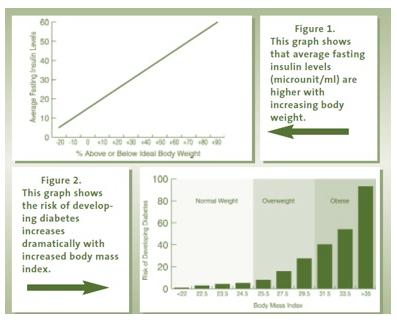Body Weight and Diabetes
 Each day, 2200 people are diagnosed with diabetes. 90-95% of these have type 2 diabetes mellitus or adult onset diabetes (Type 2 DM).1 At least 16 million Americans have diabetes but as many as half don’t know it, because they haven’t had their blood sugar tested recently. High blood sugar initially produces few symptoms with the exception of increased thirst. However, when blood sugar is elevated for many years, it can lead to blindness, kidney failure, amputations and nerve damage.
Each day, 2200 people are diagnosed with diabetes. 90-95% of these have type 2 diabetes mellitus or adult onset diabetes (Type 2 DM).1 At least 16 million Americans have diabetes but as many as half don’t know it, because they haven’t had their blood sugar tested recently. High blood sugar initially produces few symptoms with the exception of increased thirst. However, when blood sugar is elevated for many years, it can lead to blindness, kidney failure, amputations and nerve damage.Insulin Resistance Leads to Type 2 Diabetes Nearly all Type 2 DM patients have insulin resistance, which is a reduced ability of insulin to control blood sugar.2 But not everyone who has insulin resistance has increased blood sugar levels or Type 2 DM, although they are often headed in that direction. While insulin resistance has been estimated to occur in 20-30% of the US population, there are currently no routine laboratory procedures for establishing its presence. Patients with an increased waist-to-hip ratio and a strong family history of Type 2 DM, should be presumed to have clinically significant insulin resistance, especially if they also have hypertension, a low HDL and/or an elevated triglyceride level. Higher Body Fat Increases Insulin Insulin resistance requires the beta cells of the pancreas to produce more insulin day after day, year after year, to keep blood sugar levels within the normal range. It has long been known that insulin levels are elevated in individuals who are overweight.3 Figure 1 shows that the body must produce much more insulin, on average, even in the fasting state, in order to maintain normal blood-sugar levels in heavier people. For reasons that are not clear, the stress of producing all this extra insulin can take a toll on pancreatic beta cells. Eventually they can no longer keep up with the increased need for insulin. When insulin production can no longer be ratcheted up to meet the growing demand, blood sugar levels begin to rise. Eventually, both fasting and post-meal blood sugar levels drift high enough for Type 2 DM to be diagnosed. More than anything else, insulin resistance and Type 2 DM are the long-term consequence of the nutritional stress placed on the body by too many calories and too little exercise. The human body is not biologically designed to function optimally in the modern world, where the diet is unusually rich and large amounts of physical activity are no longer needed. Study Links Increased Body Weight to Risk of Developing Type 2 DM Harvard researchers examined the association between body weight and the risk of developing Type 2 DM in a study of 114,281 female nurses.4 In this study, nurses who were in general good health and between the ages of 30 to 55, were followed for 14 years. During that period, 1917 nurses were diagnosed with diabetes. As can be seen from figure 2, the risk of developing diabetes increased dramatically with increasing BMI. Compared to the thinnest women (BMI < 22.0), the heaviest women were 93 times more likely to develop diabetes during the next 14-years. However, even within the “normal” weight group, those with a BMI of 24.5 were 5 times more likely to develop diabetes than those who had the lowest BMI (<22). This study also showed that even after adjusting for present body weight, the women who had gained 11 to 17 pounds after age 18 were nearly twice as likely to develop diabetes as those whose weight had remained fairly constant. In addition, those women who had lost 11 pounds or more since they were 18 cut their risk for Type 2 DM by half or more. It should be noted that even in people with a strong family history for Type 2 DM, the risk of becoming diabetic can be dramatically reduced or at least postponed to very old age, by adopting a healthier diet and exercise program which results in long-term weight control.5 There is no known diet that can increase the body’s capacity to produce insulin in Type 2 DM patients. However, exercise and weight loss do reduce insulin resistance and so reduces the need for insulin, which improves blood sugar regulation.The bottom line: If you want to avoid becoming insulin resistant and developing diabetes, you must increase your daily activity level. If overweight, adopt a lowfat, high-fiber diet with more fruits, vegetables, whole grains, beans and less refined carbohydrates e.g. products made with a lot of white flour and sugar. Planning a diet for successful, long-term weight control, requires sophisticated knowledge about the composition of foods and the impact of those foods on appetite, blood sugar regulation and body weight. This is especially true in people with Type 2 DM. For best results, consult a registered dietitian. If you have been sedentary for a long period of time and have diabetes or cardiovascular disease, talk with your physician before starting a vigorous exercise program. References: 1. www.diabetes.org 2. DeFronzo RA. Diabetes 1988;37:667-87 3. Bagdade JD. J Clin Invest 1967;46:1549-57 4. Corditz GA. Ann Intern Med 1995:122;481-6 5. Saad MF. N Engl J Med 1988;319: 1500-6 By Dr. James J. Kenney, PhD, RD, FACN.
